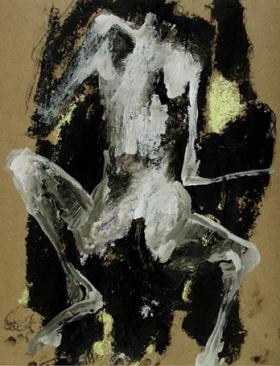Lydie Arickx "Il n'y a de repos pour personne"
As Lydie Aricks’ paintings pass through my eyes, canvases hanging on the rail act as remains of human nature, dead for social gesture, fragmented landscapes on which now only grow autonomous, left-to-themselves inner pulsions and matter convulsions, driven by the painter’s hand to a terrible fate, I hang on to the new movements of this forbidden world. The plans from which they suddenly appear, smooth pure density of cardboard, canvas’ manufactured roughness, seem to presage an execution pattern born from an immediate vision, designs born from the search for plastic obvious facts. That is the abstract part of a work which is not indebted to the soul’s affected turmoils.
Lydie Aricks endlessly takes from the traditional manneristic anatomic dissection process, searching for inner landscapes from where anthromorphism is reborn into organic reason, she’s opposing all topograhic configurations cherished and exploited by the Brueghel and Joos de Momper tradition on the fringe of classical age, establishing norms.
The blank and secret territory of the remains, anatomic field now deprived from its own autonomous driving forces and like an overripe fruit opens up on to another form of human nature which, during the time of its own defeat, generates piles of matter and unlikely lines of forces. Lydie Arickx’s vision crushes and scrutinizes that. She also influences the physical aspect of an environment, taking from the pyrenean foothills their geological cause ; she excavates under perfect lay outs,the products of fragile and ephemeral man’s work. Telluric productions, fractures and future gaps are thus highlighted, as unvoidable as the emaciating earth.
This inner world profusely exposes itself. It escapes the conditions of mimetic reproduction. To apprehend the loneliness of random physical labyrinths, the artist runs the risk of leaning on a gestual behaviour, manneristically, in the worst sense of the word, and finally produces her own forms within the painting, taking over the resonnance of the subject, as an ornemental scaffolding. This fear is now obselete thanks to constant attention, focus, without the manistestations of free disturbing figures.
The territory of her painting suddenly appears from the uncomplete metamorphosis of inner worlds, extracted with bare hands from landscape and man’s entrails. On the the grounds of their current domination modernists will probably oppose the eternal romantic plan, they won’t.
The painter only lives on future sufferings and turns them into current jubilation, now every canvas revolves around its painting, its history,barely touched by pictural gestuality. Thus the given version of The raft of the Medusa by Gericault, a major recent work, transposes the catastrophy into the painting’s geology. She succeeds in making us forget about the sublime tragedy of the event and leads us to the autonomous rootless understanding of nerves and ligaments offered as a timeless distressed humanity. Thrown into this naturalistic birth delivery, we devour the surface, going from details to details , each of them carrying an emblematic charge, resisting iconic qualities.
We embark on those fragments without ever resting or settling in, exhausted, in the monument.
Lydie Arickx also show fragments of erotic scenes. Humanity once down in the depth of melancholic knowledge may rise with a joyful serenity toward the throes of pleasure. In those fights, there’s no rest for contours or colours, no rest for flesh or sight, everyone is exposed, beauty of manner is denied. Bodies are doubled with a shadow which takes into account the soul as an anatomical mass. Tensions spread and strech across the entire representation, denying the flatness of the medium. Dismembered momuments pieces in the flesh of the world, Lydie Arick’s paintings now join the major art of fresco.
Alain Tapié 2006
